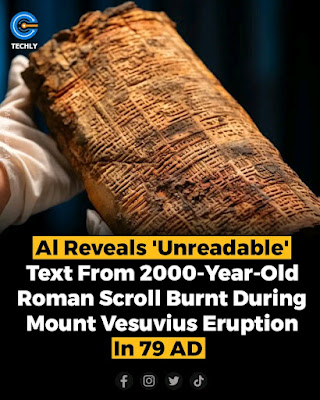Unraveling the Secrets of Antiquity: AI Deciphers 2000-Year-Old Roman Scroll Buried by Mount Vesuvius In a groundbreaking discovery, artific...
Unraveling the Secrets of Antiquity: AI Deciphers 2000-Year-Old Roman Scroll Buried by Mount Vesuvius
In a groundbreaking discovery, artificial intelligence has been employed to unveil the enigmatic contents of a charred Roman scroll dating back to the catastrophic eruption of Mount Vesuvius in 79 A.D. The scroll, preserved amidst the ruins of Herculaneum, has long perplexed historians and archaeologists due to its unreadable state.
The eruption, famously known for burying the ancient cities of Pompeii and Herculaneum under layers of ash and lava, also encapsulated invaluable historical artifacts, including this particular scroll. Traditional attempts to decipher its contents proved futile, as the scorching temperatures and volcanic debris rendered the text indecipherable to the naked eye.
Enter modern technology and the power of artificial intelligence. Researchers, armed with advanced AI algorithms and image processing techniques, embarked on a quest to unveil the secrets concealed within the ancient parchment. The process involved meticulous scanning and digitization of the scroll, creating a high-resolution dataset for the AI to analyze.
The AI algorithms employed machine learning models, specifically designed to recognize patterns and languages from various historical periods. The trained model gradually unraveled the obscured text, identifying Roman script and syntax. The groundbreaking aspect of this endeavor lies in the AI's ability to interpret the text despite the damage incurred over two millennia.
As the digital reconstruction unfolded, a narrative emerged, shedding light on aspects of daily life, societal structures, and perhaps even lost historical events of the Roman era. The deciphered text provides a glimpse into the thoughts and experiences of individuals who lived during this tumultuous time, adding a new dimension to our understanding of ancient Roman culture.
This innovative application of AI not only opens new avenues for deciphering ancient texts but also raises questions about the vast untapped potential of technology in historical research. The collaboration between archaeologists, historians, and technologists showcases the harmonious synergy between the past and the present, allowing us to bridge the temporal gap and gain insights into the mysteries of antiquity.
In conclusion, the revelation of the contents of the 2000-year-old Roman scroll by AI marks a significant milestone in historical research. It demonstrates the transformative power of technology in uncovering the secrets of the past and underscores the importance of interdisciplinary collaboration in unraveling the mysteries that history has left behind.

















COMMENTS